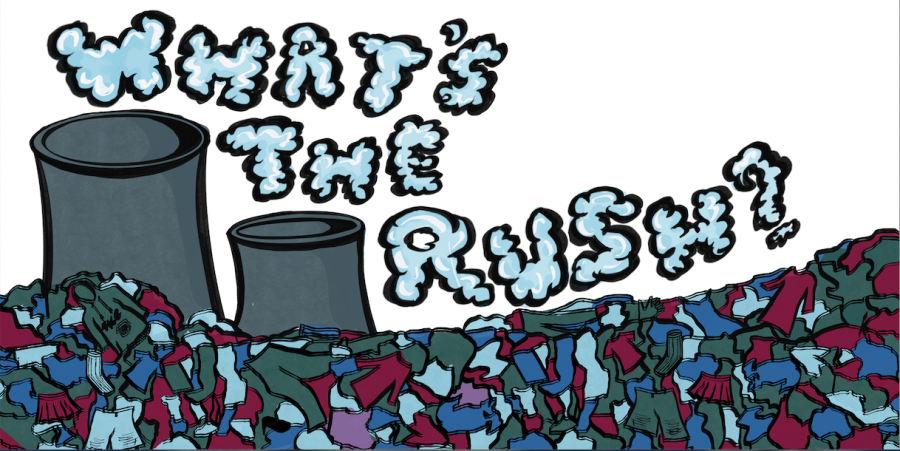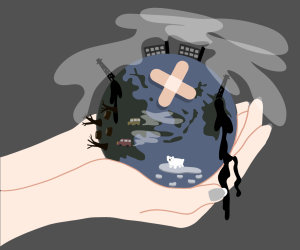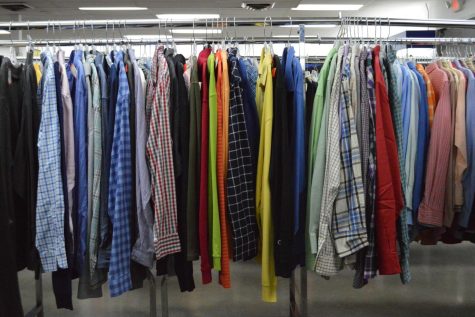What’s the rush?
Over 100 billion garments of clothing are produced and sold each year, with 92 tons of this clothing ending up in a landfill within a year.
Patchwork denim, corset-style tops, printed jeans, micro mini skirts, sweater vests, cut out tops, trucker hats, parachute pants. New trends surface weekly; it is rare they last more than a few months before they are considered outdated. To follow these microtrends, an individual must keep up with the ebb and flow of buying new clothes and inevitably discarding these garments once they are no longer in style.
According to the Salvation Army, fast fashion clothing is worn three times before getting thrown away or donated. This pattern of purchasing a new wardrobe each time a trend manifests encourages many to shop on fast-fashion websites. While the clothes are cheap, the environmental impacts of buying from these companies are dangerous. If you seek to keep up with trendy clothing while avoiding fast fashion, thrift shopping has proven to be an incredible alternative.
“Lately, I feel like clothing is made just so it can be thrown away,” Max Pricher, senior and Environmental Awareness Club member, said. “People [seem to] buy clothes just because they’re cheap and easy to [get]. They don’t care how long the clothes will last or if it is being made ethically. I’ve seen people buy clothes from Shein and [immediately] throw them away.”
According to Web Tribunal, the average American views 4,000 to 10,000 advertisements each day. Ruth Baldwin, former science teacher at North Kirkwood Middle School, said that Americans are raised to be consumers, and she believes our advertisement intake is largely responsible for this. According to Earth.org, over 100 billion garments of clothing are produced and sold each year, with 92 tons of this clothing ending up in a landfill within a year.
“As people, we have been conditioned to get our sense of value from consuming,” Baldwin said. “Our entire world revolves around the idea of people constantly buying stuff and getting rid of [it] to buy even more.”
Baldwin said people would be more conscious of what they consume if they were more educated about the environmental toll of producing and discarding clothing. According to BBC, the clothing manufacturing industry is responsible for over 10% of all greenhouse gas emissions and requires large amounts of non-renewable resources, such as crude oil.
“There is something so valuable that [comes] from making yourself slow down,” Baldwin said. “It’s easy to want the new, but give yourself some time to really think before you buy something. Consider making thoughtful choices, like going to a thrift store.”
Thrifting is one popular and eco-friendly alternative to buying fast fashion. Buying clothes secondhand is beneficial to the environment because it keeps clothing from out of landfills, lessens carbon emissions and reduces water use. According to Planet Aid, it takes 700 gallons of water to produce one cotton t-shirt— enough water to keep one person hydrated for 900 days. If you thrift a cotton t-shirt instead, it uses zero gallons of water. Mae Savens, senior, said she started thrifting because of its environmental benefits.
“I do not buy from stores in the mall, online shops or especially [fast fashion] because I really care about the environment,” Savens said. “Not only is it a better option [environmentally], thrifting is more fun, and you find more unique clothing.”
According to Treehugger, only 7% of American’s purchase secondhand clothing. Pricher said he takes pride in the fact that he thrifts the majority of his clothes, estimating that approximately 80 percent of his wardrobe is thrifted.
“Everyone should thrift more— I recommend everyone I know to try thrift shopping,” Pricher said. “I feel like with just me alone, thrifting won’t make much of a difference but it does.
Your donation will support the student journalists of Kirkwood High School. Your contribution will allow us to purchase equipment and cover our annual website hosting costs.

She/Her
Hobbies and Interests: sitting, laying, chilling, etc.
Favorite song: Blow Out by Radiohead
Favorite Quote: "I have all the world around...

She/Her
Hobbies and Interests: art, jewelry making, changing my hair color
Favorite song: No Surprises by Radio Head
Favorite Quote: "You have...












